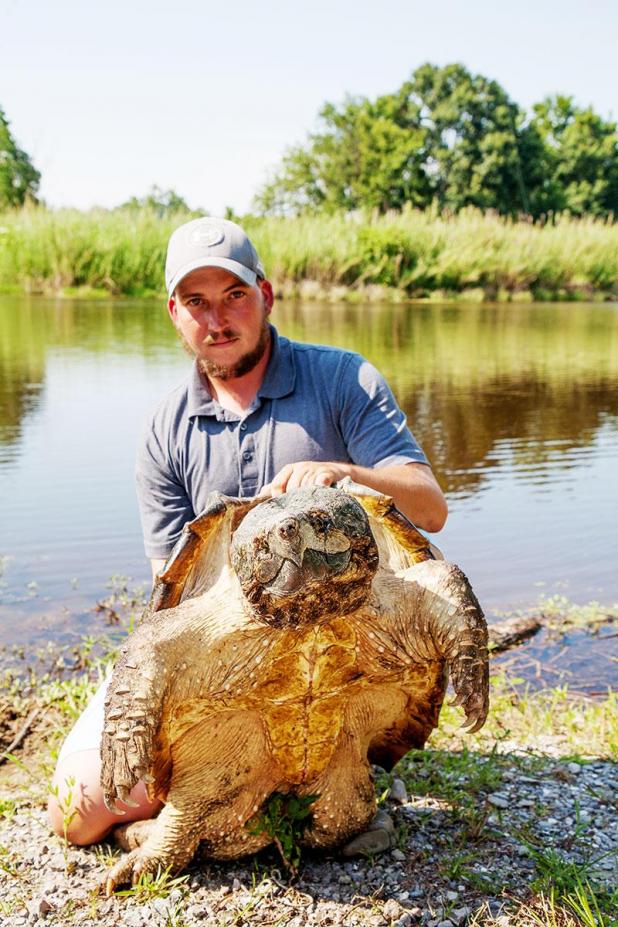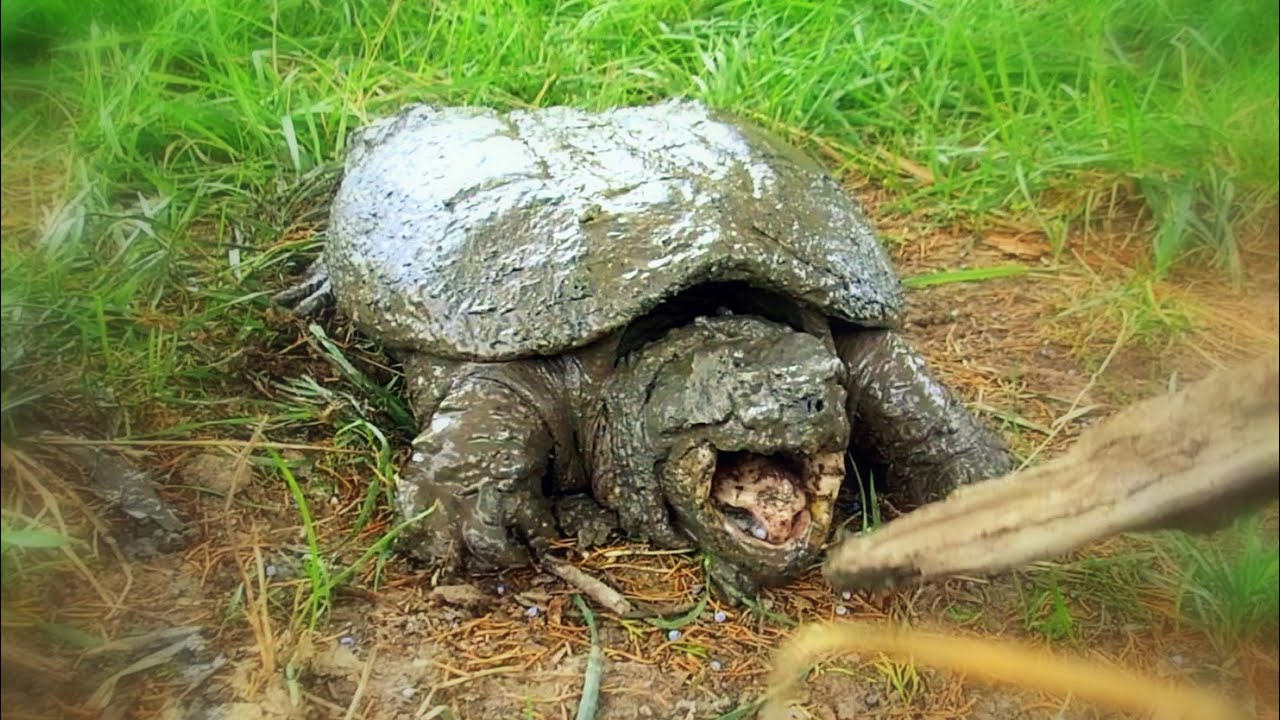To catch a snapping turtle, use a long-handled net to scoop it up swiftly and carefully. Approach it from behind to avoid its snapping jaws.
Snapping turtles are known for their aggressive behavior, so caution is advised when attempting to catch one. These turtles can be found in freshwater habitats such as ponds, lakes, and streams. When handling a snapping turtle, it is essential to be gentle and avoid getting bitten by keeping a safe distance from its powerful jaws.
By following these steps, you can safely catch a snapping turtle without causing harm to yourself or the turtle.
Understanding Snapping Turtles
Physical Characteristics
Snapping turtles are known for their rugged appearance and powerful jaws. They have a large, dark-colored shell, a long tail, and rough, ridged skin. Their heads are quite distinctive, featuring a sharp, hooked beak and powerful jaws, making them formidable predators.
Habitat And Behavior
Snapping turtles can be found in a variety of aquatic habitats, including lakes, ponds, rivers, and marshes. They are primarily solitary creatures and are often found lurking at the bottom of bodies of water, camouflaged by mud and debris. They are known for their aggressive nature and will snap at anything they perceive as a threat.

Credit: midwestoutdoors.com
Identifying Snapping Turtle Habitats
Freshwater Environments
Snapping turtles are commonly found in freshwater environments such as ponds, lakes, rivers, and marshes. These turtles prefer slow-moving or still water bodies with muddy bottoms where they can easily bury themselves to wait for prey.
Preferred Basking Spots
Snapping turtles are known for basking in the sun to regulate their body temperature. They prefer basking spots with easy access to water, such as logs, rocks, or overhanging branches. These spots provide them with a vantage point to observe their surroundings and quickly retreat into the water if they feel threatened.
Tools And Equipment Needed
When it comes to catching a snapping turtle, having the right tools and equipment is essential for a successful and safe capture. Proper gear and tools not only protect the catcher but also ensure the well-being of the turtle. Let’s delve into the necessary protective gear and capture tools required for catching a snapping turtle.
Protective Gear
Before attempting to catch a snapping turtle, it’s crucial to equip oneself with the appropriate protective gear to avoid potential injuries. The following protective gear is recommended:
- Gloves: Sturdy, puncture-resistant gloves provide protection against the turtle’s sharp claws and beak.
- Boots: High-quality, waterproof boots with thick soles offer safeguarding against potential bites and scratches.
- Eye Protection: Safety goggles or glasses shield the eyes from any splashing water or debris during the capture process.
- Clothing: Wearing durable, long-sleeved clothing can help prevent scratches and bites from the snapping turtle.
Capture Tools
Alongside protective gear, specific capture tools are essential for safely and effectively catching a snapping turtle. These tools include:
- Long-handled Net: A sturdy, long-handled net with a wide opening is useful for scooping up the turtle from a safe distance.
- Turtle Tongs: Specialized tongs allow for a secure grip on the turtle’s shell, aiding in lifting and relocating the turtle.
- Heavy-Duty Bucket: A durable bucket with a secure lid serves as a temporary containment for the captured turtle until it can be safely released.
- Snare Pole: This tool assists in capturing the turtle by gently coaxing it into a position for safe handling and relocation.
Safety Precautions To Consider
When it comes to catching a snapping turtle, it is essential to prioritize safety precautions. Approaching with caution and using proper handling techniques are crucial steps to ensure a safe and successful capture.
Approaching With Caution
When approaching a snapping turtle, move slowly and avoid sudden movements to prevent startling the turtle. Maintain a safe distance and never approach from behind as they have a long neck and can reach back quickly.
Handling Techniques
When handling a snapping turtle, always wear protective gloves to shield yourself from potential bites. Support the shell properly to avoid injuring the turtle and yourself.
Catching A Snapping Turtle
Snapping turtles are known for their aggressive nature, making them challenging to catch. Here are some effective methods:
Baiting Methods
- Use smelly baits like fish or meat to attract snapping turtles.
- Place the bait on a hook or in a trap near the water’s edge.
- Check the bait regularly to see if a turtle has taken the bait.
Trapping Techniques
- Set up a turtle trap with a bait inside to lure the snapping turtle.
- Ensure the trap has a secure entrance to prevent the turtle from escaping.
- Monitor the trap frequently to safely remove the captured turtle.
Remember to handle snapping turtles with caution due to their sharp jaws and claws.
Handling And Releasing Snapping Turtles
Handling and Releasing Snapping Turtles require care and attention to ensure the safety of both the handler and the turtle. Proper techniques for holding and releasing these creatures back into the wild are crucial to their well-being. Here are the essential procedures to follow when handling and releasing snapping turtles.
Proper Holding Procedures
When handling a snapping turtle, it’s important to use caution and follow proper holding procedures to avoid injury to both yourself and the turtle. Here are the steps to follow:
- Approach with Care: Slowly and steadily approach the turtle to avoid startling it.
- Use Protective Gear: Wear thick gloves to protect your hands from the turtle’s sharp beak and claws.
- Hold Firmly: Grasp the turtle’s shell near the back legs, ensuring a secure hold without putting pressure on the turtle’s body.
- Minimize Stress: Keep handling time to a minimum to reduce stress on the turtle.
Releasing Back Into The Wild
Once you have safely captured and handled the snapping turtle, it’s important to release it back into its natural habitat. Follow these steps for a safe and successful release:
- Choose a Suitable Location: Select a quiet, safe area near the water where the turtle can easily return to its habitat.
- Release with Care: Lower the turtle to the ground and allow it to make its way back to the water on its own.
- Observe from a Distance: After releasing the turtle, observe from a distance to ensure it safely returns to the water without any issues.
Legal Considerations
When considering how to catch a snapping turtle, it’s crucial to understand the legal considerations surrounding the capture of these creatures. In many regions, there are specific regulations in place to protect snapping turtles due to their vulnerable status as a species. It is essential to be aware of these regulations and the protected species status before attempting to catch a snapping turtle.
Regulations On Snapping Turtle Capture
In many areas, there are regulations that govern the capture of snapping turtles. These regulations may include restrictions on the methods and equipment that can be used, as well as limitations on the number of turtles that can be taken. Before attempting to catch a snapping turtle, it is imperative to familiarize yourself with the specific regulations governing their capture in your area. Failure to comply with these regulations can result in legal consequences.
Protected Species Status
Snapping turtles are often designated as protected species due to their vulnerable status in the wild. This protected status is intended to safeguard the population of snapping turtles and prevent their exploitation. It is important to recognize the protected species status of snapping turtles and to adhere to the laws and regulations that are in place to safeguard them. Violating the protected species status can lead to severe penalties and legal repercussions.

Credit: www.stmarynow.com
Conservation Efforts
Conservation efforts play a crucial role in the protection of snapping turtles, as these ancient reptiles face numerous threats to their survival. Through various initiatives and programs, dedicated individuals and organizations are working to safeguard the population of snapping turtles and their natural habitats.
Educational Outreach Programs
Educational outreach programs are essential for raising awareness about the conservation of snapping turtles. By educating the public about the importance of these reptiles in the ecosystem, individuals can learn how to coexist with snapping turtles and contribute to their protection. These programs also teach people about the threats facing snapping turtles and how they can help mitigate these challenges.
Preservation Of Habitat
The preservation of habitat is vital for the long-term survival of snapping turtles. By conserving wetlands, marshes, and other crucial habitats, we can ensure that snapping turtles have the necessary environment to thrive. Protecting these areas from pollution, development, and other harmful activities is essential for maintaining healthy populations of snapping turtles.

Credit: www.youtube.com
Conclusion
Catching a snapping turtle can be a challenging and risky task. However, with the right tools and knowledge, it is possible to catch them safely. Remember to always prioritize safety and follow local laws and regulations. By using bait, traps, and patience, you can successfully catch a snapping turtle.
Just be sure to release them back into the wild once you have caught them. With these tips, you can enjoy a safe and successful snapping turtle catch.






Leave a Reply